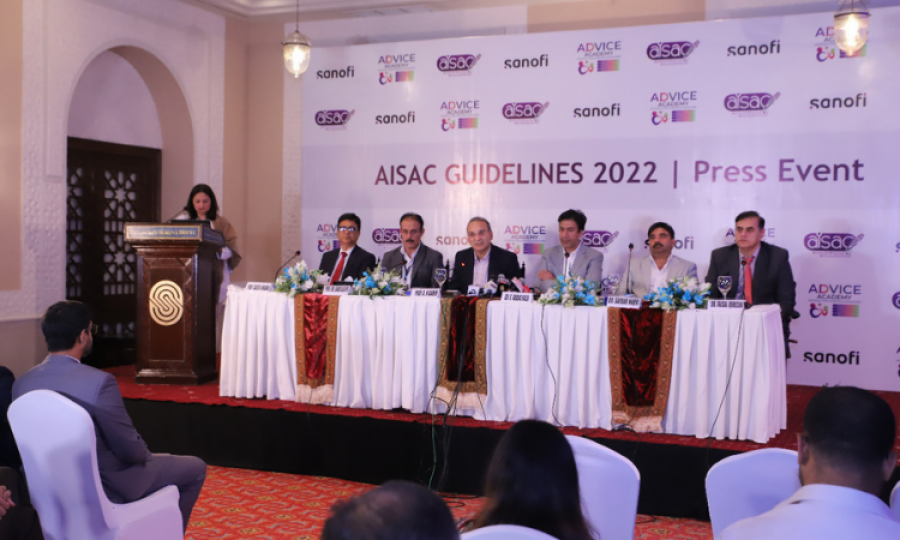Sanofi launches Diabetes guidelines for Asian countries

Islamabad: Pakistan has the third highest prevalence of diabetes in the world, with one in four adults or over 33 million people living with the condition. These figures were published by the International Diabetes Federation (IDF) Diabetes Atlas (2021). Over a quarter (26.9%) of adults living with diabetes in Pakistan are undiagnosed. China has the highest incidence of diabetes in the world (141 million), followed by India (74 million), making Asia the leader in Diabetes occurrence. Combatting this requires interventions specific to the Asian context, leading to the development of the Diabetes Guidelines for Asian countries, launched in Pakistan at the Sanofi National Diabetes Conference.
Developed by the Asian Insulin Steering and Advocacy Committee (AISAC) ahead of World Diabetes Day (14 November), these guidelines address the growing diabetes burden in Asia.
Salman Shamim - Head of Business Unit Diabetes, Pakistan & Afghanistan
“Sanofi Asia established the Asian Insulin Steering and Advocacy Committee (AISAC) to address the needs of patients in the region. We connected the 14 leading experts from Pakistan, Thailand, Malaysia, Singapore, Vietnam, Philippines, and Indonesia to collaborate, sharing their insights and expertise. We believe these Guidelines will help patients with Diabetes lead healthier lives”
The consultative process and its endorsement by Diabetes organisations are critical to the adoption of the Guidelines.
Dr S Abbas Raza - President-Elect, International Society of Endocrinology
“We formulated a consensus guidance specifically addressing the challenge of insulin adoption in Asia. Our statements have been endorsed by National Endocrine Societies of the participating countries, including the Pakistan Endocrine Society.”
Interest in the study has spread to the Middle East where the Guidelines are being considered for implementation.
Professor Dr Saud Alsifri, Honorary Professor, Taif University, Saudi Arabia
“The AISAC Consensus Statement has comprehensively addressed the problem of sub-optimal insulin adoption by keeping in mind both Asian physicians and patients. This guideline may also be easily implemented for the Middle Eastern population of Asia”
The Guidelines recommend patient education on diabetes self-management to set a positive context for insulin therapy shortly after diagnosis of diabetes, to address common myths and set. Patients should also be educated to regularly monitor their blood sugar levels to aid their management.
Prof A H Aamir, Chairman, Diabetes Task Force, Government of KPK,
“The past decade has seen an alarming increase in Diabetes in Southeast Asia with a 68% increase in diabetic population. The genetic and environmental characteristics of the Asian population, coupled with socio-economic challenges necessitate guidelines specifically tailored to this group of diabetic patients. The Asia Insulin Steering and Advocacy Committee (AISAC) was brought together by Sanofi Asia and is a much-needed step towards this goal.”
Identifying the alarming adoption of the Guidelines is simplified due to their understanding of physician and patient requirements.
Dr Safdar Naqvi, Consultant Endocrinologist, Imperial College London, Abu Dhabi, UAE
“The AISAC Consensus Statement is easy for both physicians as well as patients and will ultimately lead to optimized clinical outcomes in the Asia region.”
AISAC guidelines recommends physicians start insulin therapy if glycaemic goals are not met by oral medication. Initial insulin doses need to be customized according to each patient’s unique situation. Patients must be educated and empowered to adjust insulin themselves to ensure favourable outcomes.
Prof. Saeed A. Mahar, Past President, American Association for Clinical Endocrinologist (AACE) Pakistan Chapter.
“Delayed insulin initiation and dose adjustment is a big challenge in Asia which leads to failure in achieving control of diabetes. Therefore, nearly half of the insulin users from the region fail to achieve glycaemic targets.”
Diabetes is the seventh leading cause of death. The condition is costly and has debilitating complications such as heart attacks, stroke, kidney failure, blindness, and lower limb amputation. The condition affects half a billion people around the globe, more than 60% of whom live in Asia and western Pacific region. Experts say there will be a 46% surge in diabetic population, predicted globally and more than 68% in Southeast Asia by 2045.
Trending
Popular
Sindh pledges vigorous action to prevent poliovirus transmission
-
PMA stresses health equity on World ...
04:08 PM, 9 Apr, 2024 -
Dow University’s new rabies vaccine ...
12:18 PM, 28 Mar, 2024 -
IRD role lauded in advancing ...
02:53 PM, 12 Mar, 2024 -
Over one billion people worldwide ...
09:48 AM, 5 Mar, 2024




